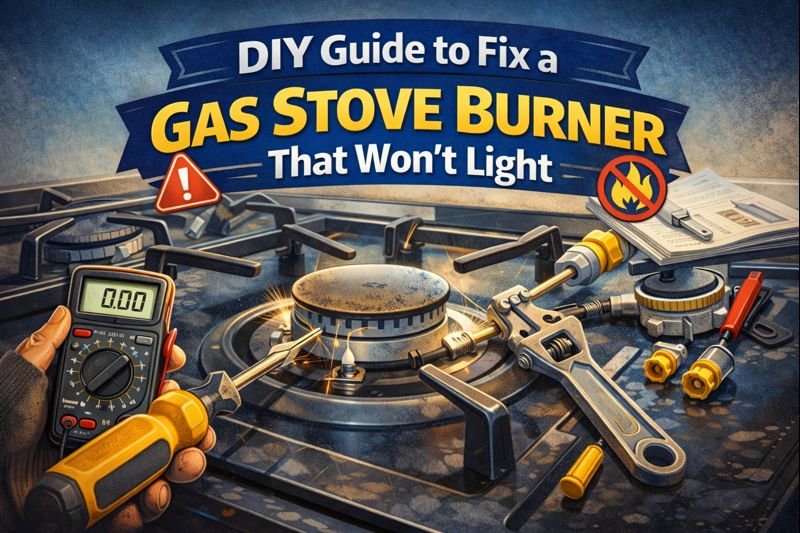
Having a gas stove burner that won’t light can be frustrating, especially when you’re in the middle of preparing a meal. Before you call a professional, you might be able to fix this common issue on your own with some simple troubleshooting steps. In this guide, we’ll walk you through the most common causes of a gas stove burner that won’t light and provide step-by-step instructions to get your stove back in working order.
Safety is always the top priority, so please follow all instructions carefully.
Common Causes of a Gas Stove Burner That Won’t Light
Before diving into the repair process, it’s important to understand why your gas stove burner may not be lighting. Here are the most common reasons:
- Clogged Burner Ports: Over time, food particles, grease, and debris can accumulate in the burner ports, blocking the flow of gas.
- Faulty Igniter: The igniter is responsible for sparking the gas to light the burner. If it’s dirty or broken, the burner won’t light.
- Loose Connections: If the burner cap or other components are out of alignment, gas flow can be disrupted.
- Gas Supply Issues: If the gas supply is interrupted or insufficient, your burner won’t light. This could be due to a problem with the gas pipe, the gas valve, or even the incoming gas source.
- Electrical Supply Issues: Gas stoves with electric igniters require a power source to function. If there’s an issue with the electrical supply, such as a tripped circuit breaker, faulty outlet, or damaged power cord, the igniter won’t receive the electricity it needs to spark.
- Gas Auto Shut-off Valves: Some modern gas stoves come equipped with safety features like auto shut-off valves, which stop the gas flow when a lid or cover is pulled down. These safety devices can sometimes malfunction, leading to a burner not lighting properly.
Tools Needed for DIY Repair
To get started, gather the following tools and materials:
- A toothbrush or small, stiff brush
- A needle or pin for unclogging burner ports
- A soft cloth or sponge
- Warm, soapy water
- A paperclip (optional, for stubborn clogs)
- Replacement igniter (if necessary)
- Safety gloves and glasses
Step-by-Step Guide to Fix a Gas Stove Burner That Won’t Light
Step 1: Ensure Safety First
- Turn Off the Gas: Before you begin any repair work, make sure the stove is off and the gas supply is shut off from the main valve to prevent gas leaks or build up.
- Do Not Smoke or flick switches: When working on a gas appliance, when gas may have built up in the room never smoke or flick switches on and off, this could cause a gas explosion.
- Ventilate the Area: Open windows or use ventilation fans to ensure the area is well-ventilated, as a precaution against gas buildup.
- Unplug the Stove: Disconnect the stove from its power source to avoid any electrical hazards while you work on it.
Step 2: Clean the Burner Components
- Remove the Burner Grates and Caps: Lift off the grates and caps to access the burner head.
- Soak in Warm, Soapy Water: Place the grates and burner caps in warm, soapy water to loosen any grease or debris.
- Scrub the Burner Ports: Use a toothbrush or stiff brush to scrub the burner ports. If there are stubborn clogs, use a needle or a paperclip to carefully clear out the ports, being mindful not to damage them.
Step 3: Check the Igniter
- Inspect for Damage or Dirt: Examine the igniter closely. It should be free of debris and in good condition. A dirty or cracked igniter may not produce a spark.
- Clean the Igniter: If the igniter is dirty, gently clean it with a soft cloth. Avoid using abrasive materials that could damage the component.
- Test the Igniter: After cleaning, try lighting the burner. You should hear a clicking sound and see a spark. If not, the igniter may need to be replaced.
Step 4: Reassemble and Test the Burner
- Align the Burner Cap: Ensure the burner cap is properly aligned and sits flush with the burner head. A misaligned cap can cause irregular gas flow and prevent ignition.
- Reassemble the Burner: Replace the grates and caps once everything is clean and aligned.
- Turn On the Gas and Test: Turn the gas back on and test the burner by turning the knob to the light position. If the burner lights, the issue is resolved. If not, proceed to the next step.
Step 5: Check the Gas Supply
- Inspect the Gas Valve: Make sure the gas valve is fully open. If the valve is partially closed, it can restrict gas flow.
- Check Other Burners: If other burners are also not lighting, the issue may be with the gas line or source. In this case, you might need to contact your gas company or a professional technician.
Step 6: Check the Electrical Supply
- Check for Power: Ensure that your stove is plugged into a working outlet. If the outlet isn’t working, check your circuit breaker or fuse box for tripped circuits or blown fuses.
- Inspect the Power Cord: Look for any signs of damage to the stove’s power cord, such as fraying or cuts. A damaged power cord may need to be replaced to ensure proper electrical connection.
- Test the Outlet: Use a multimeter or plug in another device to test if the outlet is providing power. If the outlet isn’t functioning properly, it may need to be repaired or replaced by a qualified electrician.
Step 7: Inspect Gas Auto Shut-off Valves
- Check for Safety Features: If your stove has an auto shut-off valve, ensure that the feature is not engaged unintentionally. Some models have a lid or cover that, when pulled down, automatically shuts off the gas supply to prevent accidents.
- Test the Shut-off Mechanism: Open and close the lid or cover and test if the gas supply resumes. If the shut-off valve is stuck or malfunctioning, it may need servicing or replacement.
- Manual Override: Some stoves have a manual override for the auto shut-off feature. Check your stove’s manual for instructions on how to use it safely if needed.
Gas Safety Regulations in Manhattan, New York
When dealing with gas appliances in Manhattan, New York, it’s important to be aware of local gas safety regulations. Here are key points to consider:
- Licensed Professionals: New York City regulations require that all gas line work be performed by a licensed master plumber or a licensed professional authorized by the Department of Buildings. Homeowners should avoid DIY repairs on gas lines to comply with local laws.
- Gas Safety Inspections: Landlords and property owners in New York City are required to conduct gas safety inspections periodically. These inspections help ensure that all gas lines, connections, and appliances meet safety standards.
- Automatic Shut-off Valves: For added safety, New York City mandates that automatic shut-off valves be installed on gas lines servicing residential units, particularly in new installations and certain renovations.
- Emergency Shut-off: In case of a gas leak, residents are encouraged to know where the gas shut-off valve is located and how to turn it off. It is crucial to call the utility company or 911 if a gas leak is suspected, rather than attempting any repairs.
- Carbon Monoxide Detectors: New York State law requires carbon monoxide detectors in all residences with gas appliances. These detectors must be properly installed and maintained to alert residents to potential leaks.
Safety Tips for Working with Gas Appliances
- Never Force Components: When cleaning or reassembling parts, be gentle to avoid damaging the burner or igniter.
- Use Caution with Gas: Always double-check that the gas is off when working on your stove. If you smell gas at any point, stop immediately, turn off the gas, and ventilate the area.
- Call a Professional When in Doubt: If your gas stove still won’t light after following these steps, or if you suspect a more serious issue, it’s best to call a professional appliance repair technician. Safety is paramount when dealing with gas appliances.
Preventive Maintenance Tips
- Regular Cleaning: Keep your burners, igniters, and other stove components clean to prevent buildup that can cause ignition problems.
- Inspect Burners and Igniters Regularly: Routine checks can catch minor issues before they become major problems.
- Schedule Professional Inspections: Periodic professional inspections can ensure your gas lines and stove components are functioning safely and efficiently.
By following this guide, you can address many of the common issues that prevent gas stove burners from lighting. Regular maintenance and careful troubleshooting can save you time and money, and help keep your kitchen running smoothly. Remember, safety first—if you ever feel uncertain about a repair, don’t hesitate to call in a professional!
